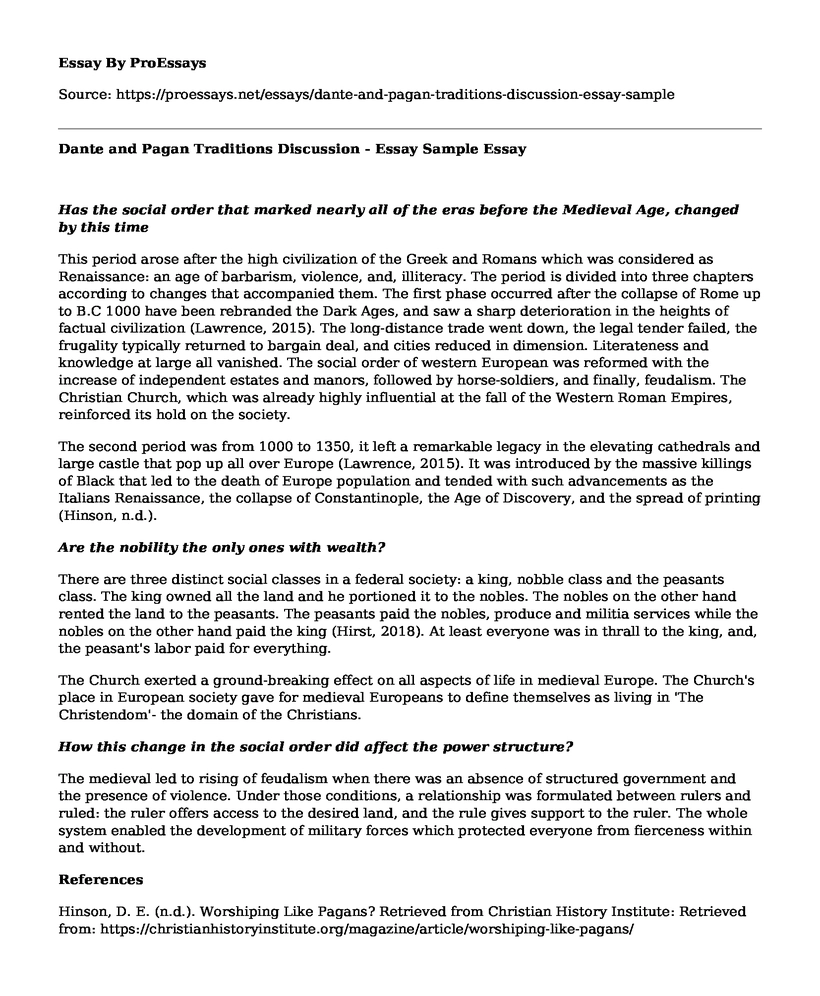Has the social order that marked nearly all of the eras before the Medieval Age, changed by this time
This period arose after the high civilization of the Greek and Romans which was considered as Renaissance: an age of barbarism, violence, and, illiteracy. The period is divided into three chapters according to changes that accompanied them. The first phase occurred after the collapse of Rome up to B.C 1000 have been rebranded the Dark Ages, and saw a sharp deterioration in the heights of factual civilization (Lawrence, 2015). The long-distance trade went down, the legal tender failed, the frugality typically returned to bargain deal, and cities reduced in dimension. Literateness and knowledge at large all vanished. The social order of western European was reformed with the increase of independent estates and manors, followed by horse-soldiers, and finally, feudalism. The Christian Church, which was already highly influential at the fall of the Western Roman Empires, reinforced its hold on the society.
The second period was from 1000 to 1350, it left a remarkable legacy in the elevating cathedrals and large castle that pop up all over Europe (Lawrence, 2015). It was introduced by the massive killings of Black that led to the death of Europe population and tended with such advancements as the Italians Renaissance, the collapse of Constantinople, the Age of Discovery, and the spread of printing (Hinson, n.d.).
Are the nobility the only ones with wealth?
There are three distinct social classes in a federal society: a king, nobble class and the peasants class. The king owned all the land and he portioned it to the nobles. The nobles on the other hand rented the land to the peasants. The peasants paid the nobles, produce and militia services while the nobles on the other hand paid the king (Hirst, 2018). At least everyone was in thrall to the king, and, the peasant's labor paid for everything.
The Church exerted a ground-breaking effect on all aspects of life in medieval Europe. The Church's place in European society gave for medieval Europeans to define themselves as living in 'The Christendom'- the domain of the Christians.
How this change in the social order did affect the power structure?
The medieval led to rising of feudalism when there was an absence of structured government and the presence of violence. Under those conditions, a relationship was formulated between rulers and ruled: the ruler offers access to the desired land, and the rule gives support to the ruler. The whole system enabled the development of military forces which protected everyone from fierceness within and without.
References
Hinson, D. E. (n.d.). Worshiping Like Pagans? Retrieved from Christian History Institute: Retrieved from: https://christianhistoryinstitute.org/magazine/article/worshiping-like-pagans/
Hirst, K. (2018). Feudalism - A Political System of Medieval Europe and Elsewhere. Retrieved from Thought. Retrieved from: Co: https://www.thoughtco.com/feudalism-political-system-of-medieval-europe-170918
Lawrence, C. H. (2015). Medieval monasticism: forms of religious life in Western Europe in the Middle Ages. Routledge. Retrieved from: https://www.taylorfrancis.com/books/9781317504689
Cite this page
Dante and Pagan Traditions Discussion - Essay Sample. (2022, Dec 17). Retrieved from https://proessays.net/essays/dante-and-pagan-traditions-discussion-essay-sample
If you are the original author of this essay and no longer wish to have it published on the ProEssays website, please click below to request its removal:
- Research Paper on Corruption in the Healthcare Sector
- Observation Work
- Trumps Proposal and Their Budgetary Impacts Essay
- What Is the Impact of US Government on the Future and Operations of OPEC? Essay
- The Relationship of Trauma to Mental Disorders Among Trafficked and Sexually Exploited Girls and Women
- Request for Extension: TESU Student Policy Explained - Essay Sample
- What the statistic is intending to communicate Paper







